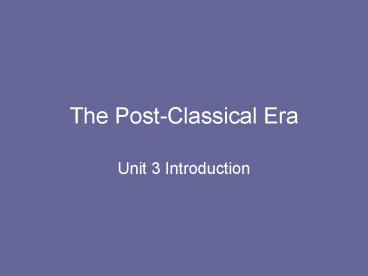The Post-Classical Era - PowerPoint PPT Presentation
1 / 13
Title:
The Post-Classical Era
Description:
The Post-Classical Era Unit 3 ... Changes and Continuities What aspects of civilization have changed in a region from the previous time period? What are the ... – PowerPoint PPT presentation
Number of Views:414
Avg rating:3.0/5.0
Title: The Post-Classical Era
1
The Post-Classical Era
- Unit 3 Introduction
2
What is the Post-Classical Era?
- Roughly 500-1450 AD
- Major Themes
- Spread of Religion Christianity, Buddhism, and
Islam spread to impact large regions - Global Trade Africa and Eurasia connected by
numerous interregional trade routes (note not
Americas) - New Concept Changes and Continuities
- What aspects of civilization have changed in a
region from the previous time period? - What are the continuities from the previous era?
3
Major Regions (by chapter)
- Middle East and North Africa (and Europe)
- South Asia (India) and Southeast Asia
- Sub-Saharan Africa (West, East, South)
- Eastern Europe
- Western Europe
- Americas (Central, South, North)
- East Asia (China)
- East Asia (Japan, Korea, Vietnam)
- Nomadic Challenge (Mongols)
4
Middle East North Africa Rise and Spread of
Islam
5
India and Southeast Asia The Arrival of Islam
6
Sub-Saharan Africa The Arrival of Islam
7
Eastern EuropeThe Byzantine Empire and the Rise
of Russia
8
Western EuropeFeudalism and Christianity
9
The Americas An Age of Empires
10
Tang and Song China A New Golden Age
11
East AsiaThe Spread of Chinese Culture
12
Nomadic ChallengeThe Pax Mongolica
13
Coach Lerchs Final Thoughts
- This era witnessed a golden age of art and
learning in the Islamic world and China, which
spread their advancements to other groups - The rise of a global trading network (except
America) meant interactions between different
regions became more frequent and had greater
cultural effects - A number of people began to identify with one of
the major world religions, although this usually
involved blending it with their own traditional
views

